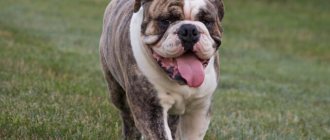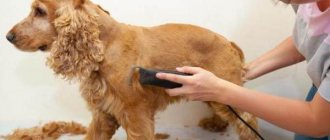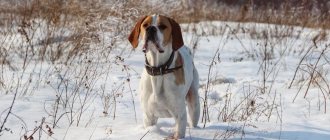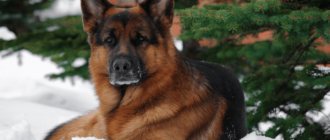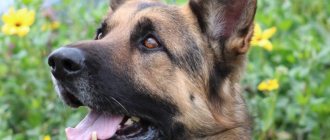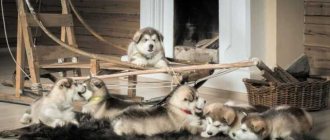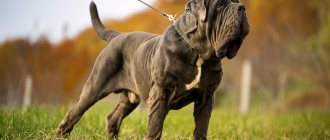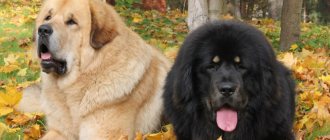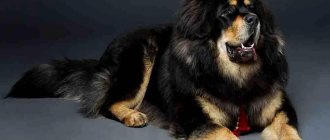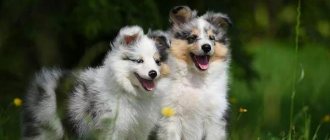| Breed name: | English Mastiff or Great Dane |
| Breed name in English: | English Mastiff |
| Country of origin: | England |
| Type: | Large dog |
| Weight: | 68-113 kilograms |
| Height (height at withers): | 71-91 centimeters |
| Color | Beige, brown, brindle |
| Wool length | Short |
| Lifespan: | 10-12 years |
| Character | Good-natured, peace-loving, gentle |
| Number of puppies (average): | Up to 12 |
| Price of puppies: | 600-1500$ |
Description
English Mastiff photo and description
English Mastiffs are huge dogs, better known as “gentle giants”. They are intelligent and calm in nature. Dogs prefer to be in a home environment and be involved in everything that happens around them.
— Advertising —
These are dogs with large square heads. They have a majestic look, a wide skull and a flat forehead with wrinkles. Individuals have well-developed cheeks. English Mastiffs have short muzzles, wide noses, and well-opened nostrils. Their lips are slightly downturned, their eyes are widely spaced, moderately large, and dark brown in color. The ears of the species are small, thin, located close to the cheeks in a relaxed state. Dogs have a strong jaw and powerful teeth.
Photo of English Mastiff dog
They have moderately long, slightly arched necks, as well as muscular, sloping shoulders. The front legs are strong and straight. The chest is wide, the ribs are rounded and curved. The back, lower back, and hind limbs of the animals are muscular and wide. The paws are round, large, with convex toes and black nails. The English Mastiff has a high-set tail that is wider at the base and tapers towards the tip. When excited, the tail is directed upward, but not above the level of the back.
Video
https://www.youtube.com/embed/
* We invite you to watch a video about the Tibetan Mastiff breed. In fact, in front of you is a playlist in which you can select and watch any of 20 videos about a given dog breed by simply clicking on the button in the upper right corner of the window. In addition, the material contains quite a lot of photos. By looking at them you can find out what a Tibetan Mastiff looks like.
| In this article: |
The Tibetan Mastiff is considered one of the rarest, most beautiful and ancient dog breeds. Many draw an analogy between mastiffs and lions. They do have some similarities. Huge size, courage, fearlessness, incredible intelligence and intelligence are inherent in these dogs. Huge dogs are very freedom-loving, but at the same time they have great endurance and friendliness. The breed got its name due to its origin. These dogs were bred in Tibet. However, the exact origin still causes controversy and questions among zoologists.
| Material content: |
Appearance
English mastiffs in nature photo
– Advertising –
This breed is a large type of dog. As adults, English Mastiffs reach the waist height of the average man. The height of males reaches 76-91 centimeters, bitches – 70-91 centimeters.
Boys tend to be heavier and weigh 68-110 kilograms, while girls weigh 54-91 kilograms. Below is the average weight of dogs at different ages:
| Age | Male | bitch |
| 4 weeks | 6,8 | 5,8 |
| 8 weeks | 13,1 | 10,8 |
| 9 weeks | 14,9 | 13,1 |
| 10 weeks | 16,3 | 14,5 |
| 11 weeks | 18,1 | 16,3 |
| 3 months | 20,4 | 17,6 |
| 4 months | 27,2 | 22,6 |
| 5 months | 36,2 | 29,4 |
| 6 months | 45,3 | 36,2 |
| 7 months | 56,6 | 40,8 |
| 8 months | 63,5 | 45,3 |
| 9 months | 70,3 | 49,8 |
| 10 months | 74,8 | 50,8 |
| 11 months | 77,1 | 52,1 |
| 12 months | 79,3 | 54,4 |
| 13 months | 81,6 | 55,3 |
| 14 months | 83,9 | 56,6 |
| 15 months | 85,2 | 56,6 |
| 16 months | 85,7 | 57,1 |
| 2 years | 92,9 | 61,2 |
| 3 years | 97,5-102,0 | 70,3-81,6 |
| 4 years | 99,7-104,3 | 72,5-86,1 |
| 5 years | 99,7-106,5 | 77,1-90,7 |
Most English Mastiffs are fawn to apricot in color. Also, there are individuals of brindle and silver colors. Their eye color ranges from brown to dark brown.
A photo of the breed is presented below.
Pros and cons of a dog
Photo of an English Mastiff in a field
Positive aspects:
- They are kind and loyal, so all family members will feel calm and relaxed in the home.
- You don't have to spend a lot of money on care.
- English Mastiffs are good with children of all ages and have a close bond with toddlers.
- These are excellent watchdogs that rarely show aggression.
- The animal is smart and therefore easy to train.
Negative sides:
- The species is a large dog, so feeding them is expensive.
- Animals drool a lot. This happens all year round.
- They have a strong hunting instinct, so dogs will chase any animal that runs away.
- They are family-oriented, hate being on their own and suffer if no one is around.
- The species is not the best choice for people who are getting dogs for the first time.
Health
Mastiff at the age of 10 years
The most common and dangerous diseases in mastiffs include:
Less dangerous diseases are:
- eye diseases: iris cyst, entropion, “cherry eye”, corneal dystrophy;
- skin diseases: allergic reactions;
- joint diseases: arthritis, hypertrophic osteodystrophy, spinal spondylosis;
Sleeping Mastiff
- diseases of the reproductive organs: cryptorchidism, unilateral cryptorchidism, vaginal hyperplasia.
- cardiovascular diseases: pulmonary stenosis, heart murmurs;
- other: hernias, Von Willebrand's disease.
History of the breed
English Mastiff close up photo
This is one of the oldest breeds. However, those English mastiffs that we can see today are completely different from their counterparts living 100 years ago. There are records about the breed that date back to the 15th century. Back then, animals were used for security and protection. However, the exact origin of the species remains a mystery. Here are some facts:
- It is believed that the dogs originated in Asia and that Phoenician traders introduced them to other parts of the world.
- When the Romans arrived on British shores, they were so impressed by the dogs that they took them with them to Rome.
- The Normans were also impressed by the large animals they discovered when they conquered the British Isles.
- There are records that the breed was purchased by the Gauls, who subsequently took the dogs into battle.
Thus, it is fair to say that the species has been around for about 2,000 years or more.
In 1872, the Old English Mastiff Club was founded, whose task was to recreate the breed. And at the beginning of the 20th century, the standard of the species was approved: gray, black, spotted and long-haired English mastiffs were no longer included in it.
During World War II, the number of individuals decreased sharply. For example, there are only 14 English Mastiffs left in the UK. Fortunately, the species was saved from extinction, and nowadays dogs are sold all over the world.
Maintenance and care
English Mastiff and owner photo
Caring for an English Mastiff is not difficult. The species has a short coat, so brushing is only required once a few days. Once or twice a year there is a period of heavy shedding - more frequent combing with a toothed comb is recommended to remove dead hair. You should regularly check and clean ears and wrinkles, and trim nails short as needed. If a lot of wax builds up in your pet's ears, it can lead to an infection that is difficult to treat. These dogs drool! Most owners keep tissues or tissues on hand to wipe them off their pet's face, as well as their own and other people's clothing.
Nutrition
Adults need to be fed twice a day: morning and evening. Since Great Danes are known to suffer from bloating, it is important to stick to their diet. Make sure you provide your animals with quality food that meets all their needs.
Photo of an English Mastiff lying on the grass
It is also important to exercise your pets so that they burn extra calories. Obesity can shorten an animal's life by several years. Therefore, it is important to accustom your dog to physical activity from childhood. English Mastiffs should not be exercised immediately before or immediately after they have eaten, as this puts them at risk of stomach torsion.
When the animal reaches full maturity, feed according to a specific schedule. So, with weight:
- From 54 kg feed 458 to 519 g of feed depending on activity.
- From 68 kg, feed from 519 to 683 g of feed, depending on activity.
- From 82 kg feed 635 to 836 g of feed depending on activity.
- From 113 kg, feed from 739 to 984 g of feed depending on activity.
Breeding
If you decide to breed your pet, make sure that this happens during the period of “estrus”. Agree in advance with the owner of the opposite sex about the date and place of mating of the dogs. If you are doing this for the first time, it is better to invite a specialist who will help you avoid mistakes. In any case, mating is best done after lunch and a walk.
English Mastiff running in nature photo
The bitch is pregnant for 63-70 days. During this period, you must take care of her more than ever. Feed her good food that is rich in vitamins and minerals, and don't let her sleep in cold or drafty conditions. Childbirth in a female lasts from three to four hours to a day. At this time, several babies appear (up to 12 pieces). Keep an eye on your mother so that she doesn’t torture her offspring with her care.
Key points in training
The main thing in training is to interest the pet and not try to force it to perform tricks if the animal is not interested in it. It is important to understand how you can motivate your dog. Usually these are all kinds of goodies, but here it is important not to spoil the animal.
It is best to have an experienced person perform all the stunts. But even a beginner will be able to teach his pet the very basics of behavior with the help of gentle words and encouragement.
Training should begin at 7 months. It is important not to procrastinate and take breaks. First, the pace of the lesson is set, and after that you can start teaching the dog basic commands. Of course, it is best to entrust the animal to a professional trainer.
Read about how to properly train a dog in the article: “Training a puppy: effective methods from dog handlers, learning commands at home.”
Puppies
English Mastiff puppy photo
The main characteristic of cubs is that they are noisy and full of life, so it is important that homes and gardens are 'proofed' from them. Protection means that you need to remove all the tools that the baby might like. Electrical cords and cables should be kept out of reach because puppies love to chew things. Also remove toxic or poisonous plants.
Babies need a lot of sleep to develop. This means that you need to create a “quiet zone”. It's also a good idea to create "play time" outside or in the garden, which will make little ones less noisy when indoors.
It is important to reduce noise levels in your home. Televisions and music should not be turned on too loudly, as this leads to stress for individuals.
Nutrition is critical, especially before 2 years of age. If fed a high-calorie diet that does not have a balanced ratio of calcium and phosphorus, puppies become prone to bone disease. Scheduled feeding rather than random feeding is recommended to avoid excessive weight gain.
English Mastiff puppies photo
As a rough guide, feed specific amounts each day, making sure the food is spread evenly throughout the day. It is best to feed young animals 3 or 4 times a day:
- 2 months – from 319 to 547 g, depending on body type.
- 3 months – from 416 to 730 g depending on body type.
- 4 months – from 459 to 809 g depending on body type.
- 5 months – from 544 to 972 g depending on body type.
- 6 months – from 617 to 1104 g depending on body type.
- 7 months – from 619 to 1124 g depending on body type.
- 8 months – from 615 to 1129 g depending on body type.
- 9 months – from 567 to 1293 g, depending on body type.
- 10 months - from 531 to 1248 g, depending on body type.
- 11 months - from 486 to 1011 g, depending on body type.
- 12 months - from 444 to 961 g, depending on body type.
- 13 months - from 441 to 904 g, depending on body type.
- 14 months – from 436 to 851 g depending on body type.
You can see a photo of the puppies below.
Dog character
Photo of an English Mastiff puppy Great
Danes may be an impressive looking dog, but they are "gentle giants" who form strong bonds with their families and owners. They are indifferent to strangers. However, animals will protect the owner and their property if they feel threatened.
These animals do not like to be left alone for a long time. Early socialization is a must for such large dogs because they are much easier to handle when they are young. Their socialization should include exposing the young to noises, people and other animals.
Mastiffs need to be given the right amount of exercise each day, as well as plenty of daily mental stimulation to prevent boredom, which leads to over-activity. It is worth noting that a well-mannered animal rarely demonstrates aggressive behavior.
English mastiff lying in the apartment photo
Due to their good appetite, feeding dogs will not cost you cheap.
The animals are playful and love to play interactive games with their owners.
This type of pet is not known to "bark", but this does not mean that the dog will not let its owner know when something strange is happening around it. Also, an animal that is left alone for a long time may begin to bark to show dissatisfaction with the situation.
Results
By listing all the main thoughts from this article, the following theses can be formed:
- This breed is excellent for guarding territory, but is extremely silent.
- Has a highly developed defender mechanism. But without proper upbringing, he can show aggression towards others.
- Young individuals must undergo special training. This is explained by the fact that managing such a large dog is quite difficult.
- The dog is quite lazy and prone to gaining excess weight. Daily walks help solve the problem.
- Not suitable for living on a chain. An animal separated from its household becomes depressed.
- It is necessary to buy a puppy only from trusted and well-known nurseries. Of course, this can be quite expensive. But a professional breeder will help you understand all the intricacies of keeping an English Dane.
- Adults are excellent companions. They are calmer, quieter and more manageable.
- Sufficiently short fur sheds heavily.
- It gets along well in an apartment or private house with a small yard. But in this case, you need to walk the dog at least 3 hours a day.
- The animal gets along well with children and the elderly. At the same time, it is quite bulky and can accidentally drop or knock over a child or an elderly person.
- Has increased salivation. But significantly less than other breeds with a similar jaw structure.
- When walking an animal, it is necessary to avoid overheating. It can lead to the death of the dog.
- And yes. The English Mastiff snores extremely loudly.
Education
It is better to start training individuals as early as possible. It must be consistent and always fair. It is important for dogs to understand what is expected of them. Babies need to be taught the "basics" as soon as they arrive in their new homes.
English Mastiff in the grass photo
Training should be short and interesting so that the animal is focused on what is required of it. With long and repeated training, it is difficult to keep the dogs' attention. Being sensitive by nature, Mastiffs do not respond well to any harsh corrections or more "heavy" methods. Pets will be happy to be rewarded for their work in the form of treats.
All puppies should be provided with limits and boundaries. The first commands that kids need to be taught are:
- Come
- Sit
- Stay
- Quiet
- leave it
- Down
- Bed.
Raising an English Mastiff
Although English Mastiffs are not naturally aggressive, this does not mean that they do not need to be raised and trained. On the contrary, like all large dogs, they need it.
The first rule that a puppy should learn in your home is that he is not the owner here. This is done by suppressing any attempts to show willfulness or even aggression, but not by physical means, but by suggestion. This breed loves gentle handling, which does not exclude the firm hand of the owner.
Each puppy's ability to train is different. Some want to please the owner and try to follow all his commands, others are stubborn. You need to use only positive reinforcement methods, and then you will achieve success. It is advisable to feed the puppy after training, which should last at least an hour. But the pet will know that a delicious lunch (dinner) and the opportunity to sleep await him ahead.
English Mastiffs have high intelligence. They understand perfectly well what you want from them and how it should be done. But they also deftly know how to manipulate the owner if they sense weakness in him. Therefore, if you think that you have come across an unusually stubborn puppy, it is better to contact a professional dog handler - most likely, the problem is you, somewhere you gave up, and the dog decided that it could do without unnecessary movements.
Don’t even think about letting your mastiff onto the sofa or bed - soon you won’t have any room left there. Only a special bed, the pet must know from the first day where its place is in the room and in the hierarchy of the pack.
Diseases
Photo of an English Mastiff sitting on the grass
Like many other breeds, the Mastiff suffers from several inherited health problems that are worth being aware of.
- Hip dysplasia
- Elbow dysplasia
- Progressive retinal atrophy
- Bone cancer
- Stones in the kidneys
- Allergies
- Damage to the cranial cruciate ligament
- Cystinuria
- Obesity
- Bloating is gastric torsion.
All of the above diseases pose a threat to the life of your pets. Basically, they cannot be treated at home; consultation and assistance from a specialist are required.
Some dogs gain weight after being spayed or neutered, and it is important to keep an eye on your dog's waistline. If your pet begins to gain weight, you need to adjust your daily calorie intake and increase the amount of exercise. Older dogs also tend to gain weight, so it is important that they are fed and exercised accordingly. Obesity shortens your pet's life by several years.
Photo of an English Mastiff with its owner
Dogs are prone to allergies. The allergens themselves are difficult to identify. But reasons may include the following:
- Certain foods
- Airborne pollen
- Dust mites
- Flea and tick bites
- Chemicals found in household cleaning products.
The veterinarian will determine the cause, and you must take measures to limit the animal’s contact with the allergen.
Where can I buy
If you decide to buy an English Mastiff puppy, then you have several ways to get the dog you want. First of all , buy an English Mastiff puppy from a kennel
, we have such nurseries in our country, and in quite large quantities. The second way is to find advertisements for the sale of dogs of this breed secondhand. Such advertisements often come across on the Internet; you will only need to choose a city closer to you or even your own city and contact the breeder.
All in all, buy an english mastiff puppy
- no problem. Each of these methods has its own advantages and disadvantages, well, let's look at the first method. So, you came to the kennel, it’s clean, the puppies are running around happy, it means everything is fine with the kennel and, most importantly, everything is fine with the puppies and this is a definite plus.
The downside awaits you a little further - the price of an English Mastiff
, a puppy from a kennel can cost 700-800 US dollars, you must admit, not every citizen of our country has that kind of money to buy a dog.
If you buy a puppy secondhand, you can save several hundred American dead presidents for your family's budget. But such a puppy will not necessarily meet all breed standards. Before buying this dog, be sure to read reviews about the English Mastiff
on the Internet, this dog may not be suitable for you. You won't get along in character.
Interesting Facts
English mastiff and pony
- The English Mastiff was recognized by the American Kennel Club in 1885.
- The breed is believed to have originated in Asia.
- Even the great Caesar mentioned this breed of dogs: he described the animals back in 55 BC.
- The largest English mastiff in the world was recognized as a pet named Aikama Zobra in 1989. His weight was about 156 kilograms. A picture from the exhibition is shown below.
- Kubla Khan kept 5,000 individuals for hunting in the 1200s.
- Some zoologists believe that the American Mastiff is simply a crossbreed of the English species, and not a separate breed.
